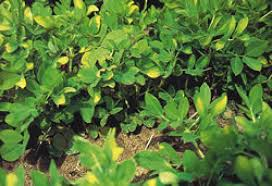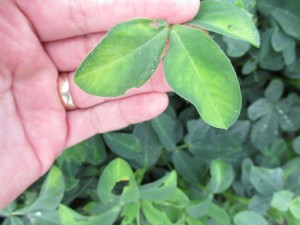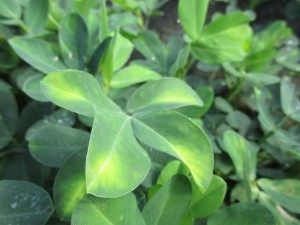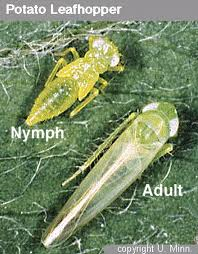
This week, while evaluating peanuts, I was reminded of a pest that is fairly common but has sporadic activity in peanuts and one we rarely spray for, the Potato Leaf hopper. I wanted to share pictures of hopper burn, a condition that results from leafhopper feeding. It is important that we recognize this damage so that it is not mistaken for disease. The presence of leafhoppers is primarily determined by yellowing of peanut foliage. However, you may notice very small green hoppers “flushing out” as you walk in the field. The Potato Leafhopper is extremely small, about 1/8 – 1/4″ and it is a wedge shaped insect. The damaged foliage will exhibit a V-shaped yellowing from the middle of the leaf toward the tip of the leaf. This chlorotic effect results when the leafhopper feeds on the underside of the leaf mid-rib, injecting toxic enzymes that breakdown foliage proteins. The toxic effect spreads from point of entry to outside of leaflet and tip, in a V-shape pattern.
The leafhopper damage may occur in mid to late season peanuts (mid July to mid September) and the burned leaves are usually not noticed until after the damage is complete. The developing population of leafhoppers may begin in areas of the field that has the most moisture and/or fertilizer. In most instances, we need to determine if leafhoppers are still in the field prior to making pest control applications. Also, in order to make an informed decision, we need to determine if both mature and immature leafhoppers are present. The use of a sweep net during scouting will help establish the presence, numbers, and maturity stage of leafhoppers. It is important to remember, that if leafhoppers are repopulating in the field, the immatures will remain and feed in the field for an extended time. The female leafhopper will lay eggs in leaf veins and stems of peanuts. The eggs hatch into nymphs in approximately 10 days and will go through five molts prior to becoming winged adults.
Although, this is a common pest in peanuts it typically does not cause economic problems. However it stands to reason, that depending upon the amount of yellowing (damage) present there is the potential for an economic impact. The chlorosis effect on foliage means that there is a reduction in the rate of photosynthesis, which could possibly result in some level of decreased yield. However, recent observations have failed to demonstrate a yield difference between treated and untreated areas. Potato Leafhopper damage will be more severe in hot, dry weather. There are no recommended cultural practices for Potato Leafhopper control but there may be reduced populations in reduced tillage systems. Also, we do not have defined threshold levels set for Potato Leafhopper populations. But, pesticide control options may be considered if damage is observed and active Potato Leafhopper infestations are present. There are several effective chemical control options such as; Orthene, Sevin, and Pyrethroids. But, please remember that the use of Orthene and Sevin can have negative effects by causing spider mite population flare ups. For this reason, the use of Pyrethroids is a preferred leafhopper control option. The Potato Leafhopper is not hard to kill and the available treatment options are typically not very expensive. Also, in order to avoid an extra trip across the field, these Potato Leafhopper insecticides can be tank mixed with fungicide sprays.
Please keep in mind, that the Potato Leafhopper is a different pest than the Three-Cornered Alfalfa Hopper. The Potato Leafhopper is much smaller than the Three-Cornered Alfalfa Hopper. Also, the Three-Cornered Alfalfa Hopper feeds on the peanut stems (resulting in girdling of stem) instead of foliage like the Potato Leafhopper. We more commonly treat for Three-Cornered Alfalfa Hopper than the Potato Leafhopper. Due to proven reductions in yield, we know that high populations of Three-Cornered Alfalfa Hopper require pesticide control. However, with Potato Leafhopper we are still determining the potential economic impact that hopper burn may have on peanut yields.





